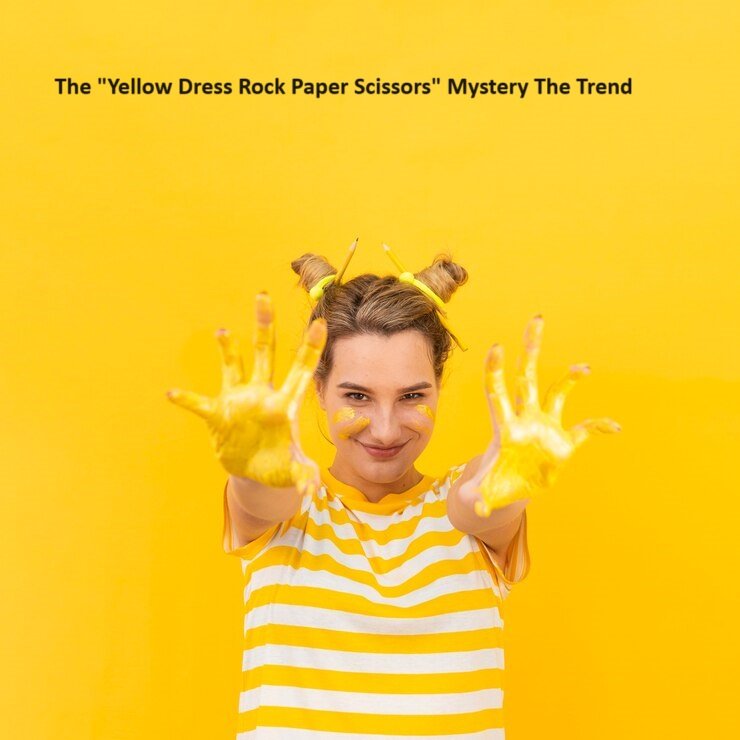Discover The Fascinating World Of Rock Paper Scissors And The Iconic Yellow Dress Name
Mar 22 2025
Rock paper scissors is more than just a simple hand game; it has become a cultural phenomenon worldwide. The yellow dress name associated with this game adds an extra layer of intrigue and curiosity. If you've ever wondered about the origins, rules, and cultural significance of rock paper scissors, along with the story behind the famous yellow dress name, you're in the right place. This article dives deep into the subject, providing you with all the information you need.
From its humble beginnings to its global popularity, rock paper scissors has captured the hearts of millions. The game's simplicity and universal appeal make it a favorite among people of all ages. But what about the yellow dress name? This mysterious reference has sparked countless discussions and debates, making it a fascinating topic for exploration.
In this comprehensive guide, we will explore the history, rules, and cultural impact of rock paper scissors. Additionally, we will unravel the mystery behind the yellow dress name, offering insights and answers to your burning questions. Let's dive in!
Read also:Experience Luxury At Hotel Ameritania In The Heart Of Times Square New York
Table of Contents
- The History of Rock Paper Scissors
- Understanding the Rules of Rock Paper Scissors
- Cultural Significance of Rock Paper Scissors
- The Enigma of the Yellow Dress Name
- Variations of Rock Paper Scissors Around the World
- Psychology Behind Rock Paper Scissors
- Rock Paper Scissors Tournaments and Competitions
- Fascinating Statistics About Rock Paper Scissors
- Tips to Win at Rock Paper Scissors
- Conclusion
The History of Rock Paper Scissors
Rock paper scissors, also known as "roshambo," has a rich and fascinating history that dates back centuries. While the exact origins of the game are unclear, historians believe it originated in ancient China. The game was later introduced to Japan, where it became known as "jan-ken." Over time, it spread across the globe, gaining popularity in various cultures.
Early Beginnings
The earliest recorded version of rock paper scissors can be traced back to the Han Dynasty in China. It was initially played as a game of divination, where players used hand gestures to predict outcomes. The game evolved over time, becoming more recreational in nature.
Spread Across Cultures
As trade routes expanded, so did the popularity of rock paper scissors. The game was introduced to Europe during the 19th century and eventually made its way to North America. Today, it is played in countless variations, each with its own unique rules and traditions.
Understanding the Rules of Rock Paper Scissors
Rock paper scissors is a game of strategy and luck, where players simultaneously form one of three shapes with their hands. Each shape represents an element: rock, paper, or scissors. The rules are simple yet engaging, making the game accessible to everyone.
Basic Rules
- Rock beats scissors (rock smashes scissors).
- Paper beats rock (paper covers rock).
- Scissors beats paper (scissors cut paper).
These rules form the foundation of the game, ensuring fair play and competition. Players take turns throwing their chosen hand gesture, with the winner determined by the outcome of each round.
Cultural Significance of Rock Paper Scissors
Rock paper scissors transcends its role as a mere game, holding significant cultural importance in many societies. It is often used as a decision-making tool, a symbol of fairness, and even as a form of artistic expression. The game has been featured in movies, books, and music, cementing its place in popular culture.
Read also:Bianca Censori Before Plastic Surgery A Comprehensive Look At Her Natural Beauty Journey
Decision-Making Tool
In many cultures, rock paper scissors is used to resolve disputes and make decisions. Its random nature ensures impartiality, making it a trusted method for choosing sides or determining outcomes. Whether it's deciding who gets the last piece of cake or which team goes first in a game, rock paper scissors is a reliable and fun solution.
Artistic Expression
The game has inspired countless artists and designers, leading to the creation of rock paper scissors-themed clothing, jewelry, and accessories. The iconic yellow dress name, often associated with the game, has become a symbol of creativity and individuality. This connection between fashion and gaming highlights the game's influence on modern culture.
The Enigma of the Yellow Dress Name
The yellow dress name has become synonymous with rock paper scissors, sparking curiosity and debate among enthusiasts. While the exact origin of the name remains a mystery, several theories have been proposed to explain its significance.
Symbolism of Yellow
The color yellow is often associated with happiness, optimism, and creativity. In the context of rock paper scissors, the yellow dress name may represent the game's playful and lighthearted nature. It could also symbolize the game's ability to bring people together and foster camaraderie.
Pop Culture References
The yellow dress name has been referenced in various forms of media, including movies, TV shows, and music videos. These references have helped solidify its place in popular culture, making it a recognizable and beloved symbol of rock paper scissors.
Variations of Rock Paper Scissors Around the World
While the basic rules of rock paper scissors remain the same, the game takes on unique forms in different parts of the world. These variations add depth and complexity to the game, showcasing its adaptability and global appeal.
Regional Differences
- In Japan, the game is called "jan-ken" and is played with slightly different hand gestures.
- In South Korea, the game is known as "baawi-bo" and includes additional rules for tiebreakers.
- In Brazil, the game is called "pedra-papel-tesoura" and is often used in traditional ceremonies.
These regional variations highlight the game's versatility and cultural significance, proving that rock paper scissors truly is a universal pastime.
Psychology Behind Rock Paper Scissors
Rock paper scissors is not just a game of chance; it also involves elements of psychology and strategy. Players often rely on intuition, patterns, and body language to gain an advantage over their opponents. Understanding the psychological aspects of the game can help improve your chances of winning.
Reading Opponents
Experienced players pay close attention to their opponents' body language and gestures, looking for subtle clues that might reveal their next move. This skill, known as "reading," is crucial for success in competitive play.
Pattern Recognition
Humans have a natural tendency to recognize patterns, even in seemingly random situations. By analyzing past moves and identifying patterns, players can predict their opponents' future actions and adjust their strategy accordingly.
Rock Paper Scissors Tournaments and Competitions
Rock paper scissors has evolved from a casual game to a competitive sport, with tournaments and competitions held worldwide. These events attract players of all skill levels, offering cash prizes, trophies, and the chance to compete against the best in the world.
World Championships
The World Rock Paper Scissors Society hosts an annual championship, drawing participants from around the globe. The competition features single-elimination rounds, with players facing off in intense matches to determine the ultimate champion.
Local Tournaments
In addition to international events, many cities and communities host their own rock paper scissors tournaments. These local competitions provide a fun and engaging way for players to showcase their skills and connect with fellow enthusiasts.
Fascinating Statistics About Rock Paper Scissors
Rock paper scissors is a game of strategy, luck, and psychology, with countless statistics and data points to explore. According to research conducted by the World Rock Paper Scissors Society, players tend to favor certain moves over others, leading to predictable patterns and trends.
Move Preferences
- Rock is the most commonly chosen move, accounting for approximately 35% of all throws.
- Paper is chosen approximately 30% of the time, while scissors make up the remaining 35%.
These statistics highlight the importance of understanding your opponents' tendencies and adjusting your strategy accordingly.
Tips to Win at Rock Paper Scissors
While rock paper scissors is often seen as a game of chance, there are several strategies and tips you can use to improve your chances of winning. By combining psychology, pattern recognition, and intuition, you can gain an edge over your opponents.
Key Strategies
- Observe your opponent's body language for clues about their next move.
- Look for patterns in their throws and adjust your strategy accordingly.
- Stay calm and focused, avoiding predictable or repetitive moves.
By incorporating these tips into your gameplay, you can increase your chances of success and become a rock paper scissors master.
Conclusion
Rock paper scissors is more than just a simple hand game; it is a cultural phenomenon with a rich history and global appeal. From its origins in ancient China to its modern-day popularity, the game has captivated millions of players worldwide. The enigmatic yellow dress name adds an extra layer of intrigue, making the game even more fascinating.
In this article, we explored the history, rules, and cultural significance of rock paper scissors, as well as the mystery behind the yellow dress name. We also discussed variations of the game, psychological strategies, and competitive tournaments, providing you with a comprehensive understanding of this beloved pastime.
We invite you to share your thoughts and experiences in the comments below. Have you ever participated in a rock paper scissors tournament? Do you have any tips or strategies to share? Don't forget to explore our other articles for more insightful content on a variety of topics.


